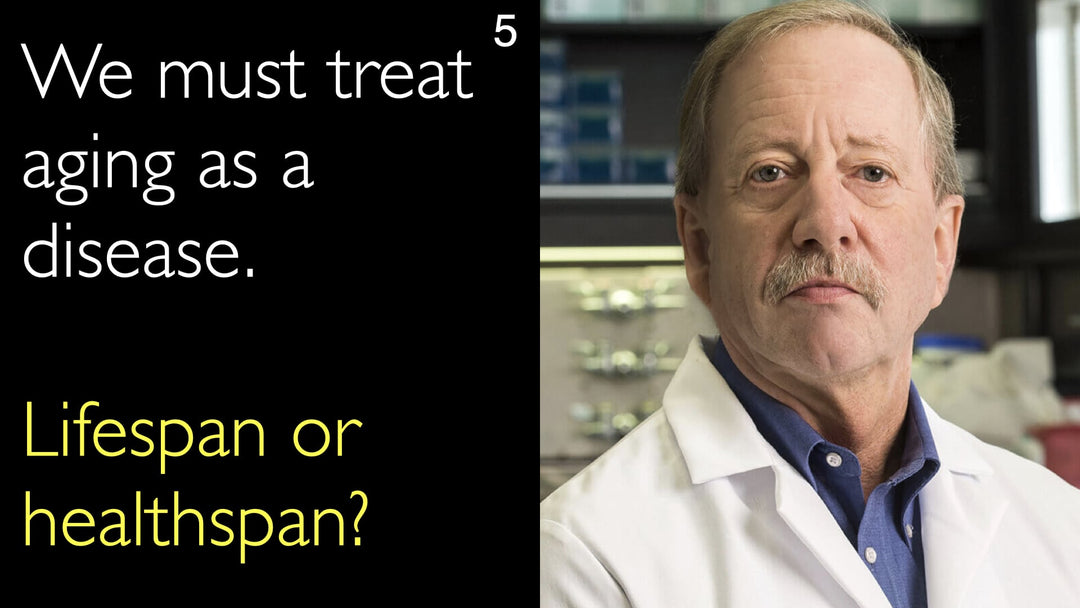Johtava ikääntymisen biologian asiantuntija, lääketieteen tohtori Steven Austad, selventää eliniän ja terveen eliniän (healthspan) keskeistä eroa. Hän korostaa, miten ikääntyminen on taustalla kaikissa merkittävissä sairauksissa. Tohtori Austad kannattaa ikääntymisen perusmekanismien kohdentamista, mikä voisi viivästyttää tai jopa ehkäistä useita ikään liittyviä sairauksia samanaikaisesti. Hän pohtii myös ikääntymisen luokittelun sairautena aiheuttamia sääntelyhaasteita.
Ikääntymisen kohdentaminen sairauksien ehkäisyyn ja terveyden keston pidentämiseen
Hyppää kohtaan
- Eliniän pituus vs. terveyden kesto
- Ikääntyminen sairautena
- Sairauden vaikutus ikääntymiseen
- Ikääntymisen perusprosessien kohdentaminen
- Sääntelyhaasteet
- Koko tekstitys
Eliniän pituus vs. terveyden kesto
Lääketieteen tohtori Steven Austad korostaa, että eliniän pituus ja terveyden kesto eivät ole sama asia. Ihmisen elinikä on kasvanut nopeasti viimeisten 200 vuoden aikana, mutta terveyden keston kasvu on ollut hitaampaa. Elämän loppuvaiheen terveyden heikkenemisen ajanjakso on nykyään pidempi kuin vuosikymmeniä sitten. Austad painottaa, että terveyden keston määrittävät tekijät vaativat ymmärrystä.
Ikääntyminen sairautena
Lääketieteen tohtori Steven Austad käsittelee liikettä, joka pyrkii luokittelemaan ikääntymisen uudelleen sairaudeksi. Hän huomauttaa, että tällä voi olla markkinointiedut, koska se herättää enemmän huomiota. Itse ikääntyminen ei kuitenkaan ole sairaus, vaikka se vaikuttaakin merkittävästi sairauksien kehittymiseen. Tämä ero on ratkaisevan tärkeä lääketieteellisen tutkimuksen ja hoidon kannalta.
Sairauden vaikutus ikääntymiseen
Lääketieteen tohtori Steven Austad selittää sairauden ja ikääntymisen kaksisuuntaisen suhteen. Sairaudet voivat nopeuttaa ikääntymisprosessia. Hän mainitsee esimerkkinä HIV-tartunnan saaneet henkilöt, joiden tauti on hyvin hoidossa, mutta jotka silti ikääntyvät nopeammin. Tämä voi johtua kroonisesta matala-asteisesta tulehduksesta tai pitkäaikaisen antiviralisen hoidon aiheuttamista reaktioista. Toisena esimerkkinä on syöpäkemoterapia, joka hoitaa syöpää tehokkaasti, mutta voi aiheuttaa merkittäviä sivuvaikutuksia ja nopeuttaa ikääntymistä.
Ikääntymisen perusprosessien kohdentaminen
Lääketieteen tohtori Steven Austad ehdottaa lääketieteellisen tutkimuksen suunnanmuutosta. Hän kannattaa ikääntymisen perusprosessien kohdentamista, mikä voisi viivästyttää tai estää kaikkia suuria ikään liittyviä sairauksia ryhmänä. Hän vertaa tätä syöpää ehkäisevään lääkkeeseen, joka samalla estäisi dementiaa, sydäntautia ja nivelrikkoa. Tämä edustaa täysin uudenlaista lähestymistapaa biomedikaaliseen interventioon ja siirtymistä pois yksittäisiin sairauksiin keskittyvästä tutkimuksesta.
Sääntelyhaasteet
Lääketieteen tohtori Steven Austad korostaa merkittävää esteitä uudelle lähestymistavalle: sääntelyviranomaisia. FDA hyväksyy lääkkeet vain tiettyihin sairauksiin. Austad kertoo tapaamisesta FDA:n kanssa noin viisi vuotta sitten, jossa keskusteltiin ikääntymiseen kohdistuvien lääkkeiden kokeiluista. Keskustelu piti kehystää siten, että lääkettä pidettäisiin yksittäisenä hoitona useisiin sairauksiin. FDA ei esimerkiksi tunnusta sarkopeniaa (ikään liittyvää lihaskatoa) sairautena, mikä estää lääkkeiden hyväksymisen sen hoitoon. Austadin mukaan tämä on enemmän kuin semanttinen ongelma – se vaikuttaa perustavanlaatuisesti tieteen tekemisen ja hoitojen kehittämisen tapaan.
Koko tekstitys
Lääketieteen tohtori Anton Titov: Tämä tuo esiin erittäin tärkeän eron eliniän pituuden ja terveyden keston välillä. Nämä kaksi eivät välttämättä korreloi. Miten sairausprosessi vaikuttaa ikääntymiseen?
Lääketieteen tohtori Steven Austad: Olet oikeassa. Ne eivät ole sama asia. Ihmisen elinikä on kasvanut nopeasti – noin kuusi tuntia päivässä – viimeisten 200 vuoden aikana. Terveyden kesto on kasvanut hitaammin. Itse asiassa terveyden heikkenemisen ajanjakso elämän lopussa on hieman pidempi kuin 20–30 vuotta sitten.
Meidän on siis ymmärrettävä, mikä määrittää terveyden keston, ja ajateltava sitä eri tavalla kuin sairauksia. Alalla on ollut liikettä luokitella ikääntyminen uudelleen sairaudeksi. Vaikka siinä voi olla markkinointietuja – se saattaa herättää enemmän huomiota – ikääntyminen ei ole sairaus, vaikka se vaikuttaakin sairauksiin.
Sairaudet puolestaan voivat paradoksaalisesti vaikuttaa ikääntymiseen. Yksi mielenkiintoisimmista havainnoista on tullut HIV-potilailta, joiden tauti on erittäin hyvin hoidossa. Veressä on hyvin vähän virusta, mutta he ikääntyvät nopeammin.
Johtuuko tämä matala-asteisesta tulehduksesta? Tiedämme, että krooninen matala-asteinen tulehdus lisääntyy iän myötä. Se voi liittyä myös pitkäaikaiseen antiviraliseen hoitoon. Emme tiedä varmasti, mutta tämä korostaa sairauden vaikutusta ikääntymiseen, kuten myös ikääntymisen vaikutusta sairauteen.
Esimerkiksi syöpäkemoterapia voi nopeuttaa ikääntymistä. Se voi olla erinomainen hoito syöpään, mutta aiheuttaa merkittäviä sivuvaikutuksia.
Lääketieteen tohtori Anton Titov: Nostat esiin sekä ikääntymisen vaikutuksen sairauksiin että sairauden vaikutuksen ikääntymiseen. Kun otetaan huomioon satojen miljardien dollareiden määrä, joka käytetään sairauksien, erityisesti myöhäisvaiheen tautien torjuntaan, eikö olisi järkevää suunnata enemmän tutkimusta ikääntymisen perusprosesseihin ja selvittää, voidaanko niihin vaikuttaa syövän ja dementia tasolla?
Lääketieteen tohtori Steven Austad: Kyllä, se on hyvä pointti. Yritämme välittää, että ikääntyminen on kaikkien suurten sairauksien ja kuolinsyiden taustalla. Jos pystymme kohdentamaan ja muokkaamaan taustalla olevia prosesseja, voimme viivästyttää tai estää kaikki nämä sairaudet ryhmänä.
Ajattele asiaa näin: Kehitän syöpää ehkäisevän lääkkeen, jolla on useita sivuvaikutuksia. Yksi niistä on dementiaehkäisy, toinen sydäntautien ja nivelrikon ehkäisy. Tästä me puhumme.
Tämä on täysin erilaista biomedikaalisen intervention ajattelutapaa kuin mitä olemme aiemmin harjoittaneet. Koko lääketiede on jakautunut eri sairauksien tutkimukseen: onkologeille, neurologeille. Mutta viime aikoina alan asiantuntijat ovat alkaneet puhua toisilleen ja tajunneet, että sama prosessi on syöpien, sydäntautien ja hermoston rappeumasairauksien taustalla.
Ehkä olemme tehneet väärin. Ehkä haluamme kohdentaa ikääntymisen perusprosesseihin. Yksi este tälle on FDA, joka hyväksyy lääkkeet vain tiettyihin sairauksiin.
Tapasimme FDA:n edustajia noin viisi vuotta sitten ja yritimme saada heidän näkemyksensä ikääntymiseen kohdistuvien lääkkeiden kokeiluista. Emme voineet puhua "ikääntymisen hoidosta", vaan piti puhua yksittäisestä lääkkeestä, joka kohdistuu useisiin sairauksiin.
Kun esitimme asian näin, FDA sanoi periaatteessa hyväksyvänsä sen. Toivomme, että FDA muuttaa näkemyksään. Esimerkiksi FDA ei pidä sarkopeniaa (ikään liittyvää lihaskatoa) sairautena, mikä estää lääkkeiden hyväksymisen sen hoitoon.
Tämä on enemmän kuin semanttinen ongelma – se koskee tiedon hankkimisen ja hoitojen kehittämisen perustaa.




